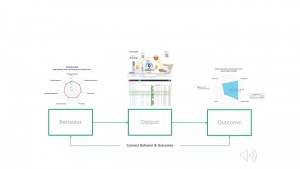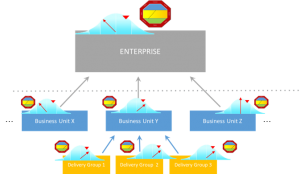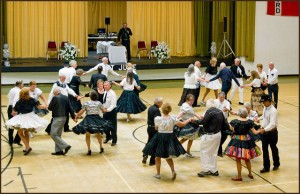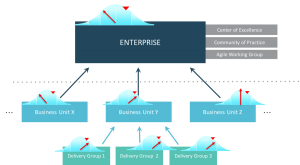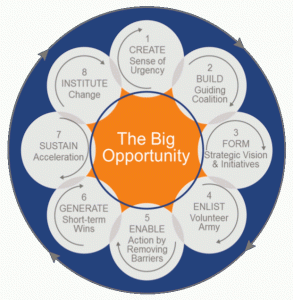This was initially posted at CA Agile Blog.
As a transformation consultant, I’ve had the opportunity to work with many agile Centers of Excellence (COEs). And along the way, I’ve developed a model for an agile COE that I have applied in both small and large organizations. I’ll introduce that model in this blog and provide more details in follow-up posts.
But first, some background. The first agile COE that I worked with served a 4,000-person IT organization and had almost 20 full-time professionals. This experience was great because it taught me the components to consider in an agile COE. However, the biggest lesson from this experience was that the only true measure of an agile COE should be the number of business units/delivery groups you transform to an agile approach. For a multitude of reasons, this COE focused more on adopting the Rally application lifecycle management (ALM) platform (now called CA Agile Central), developing a bespoke agile framework, and creating and delivering training—and less on transformational coaching of the business units and delivery groups.
Where the agile manifesto states a preference for working software over comprehensive documentation, a manifesto for an agile COE should state a preference for agile delivery groups over COE capabilities. An agile COE should remember that its value happens when the organization incorporates agile development into the way the organization works—into its organizational DNA. Everything else is a means to that end.
A Model for an Agile COE
With the caveat of the last paragraph, let me describe a model for an agile COE—a means to the end of tipping the enterprise. The model has eight components that are organized into three areas.
Process
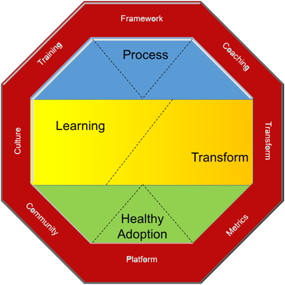 The process area involves the framework (e.g., Scaled Agile Framework®, Large Scale Scrum) that the organization will employ, coupled with the training and coaching that will be provided to the organization. One lesson I learned in working with the agile COE described above was the need to align the framework, training and coaching. The coaching hub of that agile COE employed external coaches who needed to be corralled to coach the approach that was documented in the framework and taught in the training. The best way to ensure that the framework, training and coaching align is to have the same group handle all three. That way, the framework and training reflect the needs that the coaches see in their work with business units and development groups.
The process area involves the framework (e.g., Scaled Agile Framework®, Large Scale Scrum) that the organization will employ, coupled with the training and coaching that will be provided to the organization. One lesson I learned in working with the agile COE described above was the need to align the framework, training and coaching. The coaching hub of that agile COE employed external coaches who needed to be corralled to coach the approach that was documented in the framework and taught in the training. The best way to ensure that the framework, training and coaching align is to have the same group handle all three. That way, the framework and training reflect the needs that the coaches see in their work with business units and development groups.
Healthy Adoption
I tried using different titles for this section, including “sustained adoption.” But I finally settled on “healthy adoption” for the combination of platform, community and metrics—because the goal of healthy adoption is continuous improvement.
CA Agile Central is an ALM platform, and as such, is a component of most of the agile adoptions that I’ve worked on. Even if the ALM tool employed is not CA Agile Central ;-(, the platform should be considered part of the COE offerings to the organization.
There are benefits to centralizing the administration of the ALM platform, including consistency in its application and sharing useful customizations. But I’ll share a word of caution: The COE needs to guard against constraining the process being followed by the organization. For example, the platform employed at the COE mentioned previously made the administration of Kanban flows more onerous than the administrators liked. As a result, the platform team pushed back on using Kanban in the organization—it was a little too much of the tail wagging the dog.
The aforementioned COE taught me the importance of community building: communications, events such as lunch-and-learns, and establishing a community of practices. While the COE is focused on transforming the enterprise, part of its job is also selling successes. I’ll never forget the impact of a video disseminated by the COE in which a well-respected business owner said, “We will never do anything other than agile in the future.”
Metrics can be a tricky area, and they’re often used to communicate the extent of the enterprise’s agile adoption. I suggest that metrics contribute to a more important goal of continuous improvement for how a team, delivery group and business unit use agile in their daily work. When continuous improvement is the objective, the metrics should correlate behaviors to desired outcomes.* Luckily, CA Agile Central was involved when the Software Engineering Institute created the Software Development Performance Index. Tying those outcomes to behaviors helps guide continuous-improvement efforts.
Transformation and Learning
The middle area, transformation and learning, focuses on transforming the enterprise and affecting the culture of the organization.
As stated in my previous blog post, I believe in transforming an enterprise by one business unit/delivery group at a time, and that it takes three such “tips” to fully tip that business unit. The transformation side of this equation entails a measured, purposeful transformation of business units within the enterprise.
The first step in successfully changing culture is changing behavior. That’s why I pair the two at the same level in the COE. That said, in any transformation that I’ve facilitated, the existing culture is often raised as a barrier to the transformation. So, in addition to changing the way delivery groups behave, it’s important to align the leadership of the organization with the new behavior.
I’m a big fan of the learning organization work of Peter Senge, author of the Fifth Discipline series of books, and founding chair of the Society for Organizational Learning. Recently, I discovered the book, “The Lean Machine. How Harley-Davidson Drove Top-Line Growth and Profitability with Revolutionary Lean Product Development,” in which Dantar Oosterwal describes how Harley-Davidson applied the lessons of the Fifth Discipline.
The reason I split this level into transformation and learning is that over time, the COE will shift from being transformation-dominated to learning-oriented.
The COE and the Rule of Three
The following figure depicts how a COE changes as a business unit or delivery group tips, and illustrates the focus on transformation to one of learning. At any point in time, the COE’s work within the enterprise will be a mix of transformation and learning.
The Learning COE
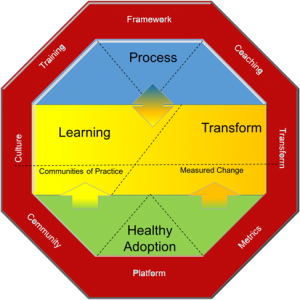 Over time, an agile COE should work itself out of the transformation business and shift to being a learning amplifier for the organization.
Over time, an agile COE should work itself out of the transformation business and shift to being a learning amplifier for the organization.
This graphic illustrates how the three areas of the COE interrelate in a learning-oriented COE.
Communities of Practice
Over time, the COE should be replaced by communities of practice where the practitioners within the organization communicate and learn from each other rather than from the COE.
Measured Change
I’m a fan of measured change methodology, such as the Lean Change Method by Jeff Anderson. These change methods employ a Lean Startup experimental mindset to learn from each transformational activity.
As the big lift of the transformation is complete, the focus should shift to metrics-driven continuous improvement, which should follow this same experimental mindset established during the transformation work. In fact, it’s during this continuous improvement that the experimental approach of such change methods find their greatest traction.
Process
While I believe in starting with an industry-proven process framework, such as the Scaled Agile Framework, I also trust in ShuHaRi where the organization adjusts the framework over time. To empower learning within the organization, the presentation of any framework should support the practitioners’ comments and conversations about the framework—because that’s where the organization will start to contribute its HAs and RIs to the process.
Stay Tuned …
In my next blog post, I’ll provide more details about each of the COE model areas and describe the COE’s role in a learning organization.
*A shout-out to my CA Agile Central colleague, Ryan Polk, for introducing me to the six boxes approach to performance thinking (www.sixboxes.com). The “Connect Behavior and Outcomes” graphic is based on six boxes performance chain.
